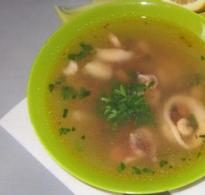Oysters - benefits and harms. What is the right way to eat them? How to eat raw mussels and oysters
Oyster- This is one of the many seafood that belongs to the family of marine molluscs. There is no person who has not heard about the use of oysters in cooking. Oysters can be eaten not only in restaurants and cafes, they can also be cooked at home, as there is a large number of all kinds of recipes for their preparation.
If we talk about where oysters are found, then the seas in the tropics are considered their habitat. Oysters don't like too much salt water, so sometimes they can be seen in rivers.
As for the offspring, oysters spawn, and they begin to do so in the spring. The spawning period can last up to six months, ending by the end of the summer period. For favorable spawning, oysters need quite warm water. The most interesting thing is that the eggs remain in the oyster until they are fertilized and hatch. Thus, already born mollusks come out of the shell, which move around the reservoir until they find appropriate place to attach to it and start your life.
The most valuable and high-quality at the moment are Norwegian oysters, which are collected in natural Norwegian reservoirs. Also on the market you can find oysters from other countries: Japan, USA, South Korea and others.
When choosing oysters, you should pay attention to their freshness. Fresh oysters should have a solid color. Their sashes must fit snugly against each other, without even the smallest crack (see photo). If you notice a small gap between the shells, this means that the oyster is stale, and it is better not to use such clams as food, otherwise you can get serious poisoning.
Types of oysters
About fifty are known today. various kinds oysters, most of which are edible. Formally, all types of oysters are divided into two types: flat and deep.
The flat-faced oyster includes four distinct varieties of clams that differ in flavor, appearance, and market value. The flat type of oysters includes the following varieties:
- The most prized flat oysters by gourmets are Marin Oleron. They have very delicate structure, rich taste and amazing aftertaste. They are the most popular representatives of this type of oyster.
- Belon- Another variety of flat oysters, which is collected in the French province. It differs from its relatives in appearance, color in light gray tones, and also has a rather pungent smell.
- Bouzigues- a type of flat oyster that is found only in the Mediterranean Sea. They differ from other types of oysters in that they give off a spicy aroma when eaten, and they also have a pronounced salty flavor.
- Yellow-green shell and small size characterize the type of oyster called Gravette. Unlike their relatives, this species molluscs, although not large in size, but has a very fleshy body.
Deep oysters are collected mainly only within the Pacific Ocean. This type of oyster is usually divided into two categories: exquisite and special. Gourmets have a slightly smaller volume of juice and meat than specials, which differ significantly in price.
This type of oyster is usually grown in special tanks, which are filled with special algae. Keeping oysters in such tanks improves the quality of the oyster. The deep oyster species includes five varieties:
- Most high content fat content and a slight salty aftertaste characterizes oysters fin de clair. They are kept in tanks and supplied with algae as an additional source of nutrition.
- Oysters, which are larger and also contain more meat, are called Special. This variety of oysters is kept in tanks for up to two months to saturate the oyster with the necessary elements.
- Blue Oyster differs in a specific color, which is achieved by keeping mollusks in a special aquarium, which includes blue clay. Thanks to her, this type of oyster contains great amount beneficial trace elements.
- Croesus- This is an Irish type of oyster, which is characterized by high fat content and high meat content.
- Oysters, which differ from their counterparts in a rather elegant shell shape, as well as a sweetish pleasant aftertaste, and the smell of iodine, are called White pearls.
The maximum known size of this type of oyster reaches 50 centimeters. But such individuals are very rare. On average, the size of deep oysters varies between 5-20 centimeters.
Those who have come across oysters know that opening them is not as easy as it might seem at first glance. First of all, it is necessary to clarify that in no case should you open oysters with hammers or any other objects that can injure the shell, otherwise you can spoil the taste of the oyster.
To properly open an oyster, you need to arm yourself with a small sharp knife, or even better with a scalpel, and carefully draw along the connection line of the shell valves. In this way, the muscles of the mollusk are cut, which hold the shell back, so that you can open it. 
If you decide to visit a French restaurant, then you should definitely try the oysters! If you don't know how to eat them properly, don't worry! We will enlighten you on this matter.
To begin with, I would like to note that if you decide to cook and taste oysters at home, then they are served on a tray in an amount that is a multiple of six. Also on the tray should be slices of fresh lemon to add sophistication to the dish. Oysters should definitely be served with white wine, since only in combination with this drink can oysters reveal their full taste.
If you're going to be eating oysters in a restaurant, the first thing you need to do is make sure the oyster is fresh. Determining this is very simple: the shell flaps must be closed. As a last resort, they open right in front of visitors to showcase the freshness of the oyster. Do not order and do not use open oysters as they may be damaged.
And it is very simple to eat oysters correctly: take an open oyster shell in your left hand, and a two-pronged fork in your right hand, which is designed for this purpose. The tines of the fork should be brought under the body of the mollusk, and then carefully removed from the shell with gentle movements. The oyster can be dipped in the oyster sauce that is being served, or it can be applied directly to the clams while they are still in the shell. It is also customary to sprinkle oyster meat lemon juice before use.

You can't chew an oyster. It is swallowed in one motion, and then washed down with white wine. It is also not customary to drink the liquid from the shell of oysters. There may be sand if the oyster was caught during a storm.
cooking secrets
To learn how to cook oysters correctly, you should clarify that you only need to buy fresh oysters with tightly closed shells.
If you already have fresh raw oysters on hand, then you can start cooking. There are many recipes for oysters. They can be added to salads, served as a separate appetizer, supplemented with other dishes.
Most often, the baking method is used to prepare oysters: due to the content of juice in the shell, the oyster is baked in it, after which it is served at the table. Before baking, the sink must be cleaned of dirt and algae! Also, for the preparation of oysters, the method of stewing in the sink and without it is used. 
Especially enterprising people can boil and fry oyster meat, but this is not entirely correct. It is best to cook oysters by baking, adding fragrant spices taste.
Beneficial features
IN useful properties oysters no doubt. Like most of all seafood, oysters have a beneficial effect on the human body, helping it to strengthen immune system and even get rid of some diseases. So, oyster meat has a good tonic effect, and also, due to the content of various amino acids in it, it can neutralize the development of cancerous tumors. Also oysters able to enhance sexual desire, being one of the best aphrodisiacs.
Harm of oysters and contraindications
The harm of oysters is rather doubtful. Oysters can only harm people who are allergic to them and seafood in general. There are very few contraindications for oysters: it is not recommended to use them only for people with allergies, as well as for pregnant women in the last stages of pregnancy. Also, oysters can be harmful if they are stale.
Compound
The composition of oysters can be envied by most seafood. Oyster meat contains elements such as proteins, fats, glycogen carbohydrates, as well as a large amount of vitamins, in particular, there are a lot of B vitamins in them.
Concerning minerals, then oysters contain iodine, potassium, calcium, zinc, phosphorus, iron and copper. However, the amount of content useful minerals in oysters is so high that six oysters will be enough to replenish the daily supply of minerals for the body.
Among other things, oysters contain amino acids and saturated fatty acids, such as omega-3, which, when regular use can positively influence the immune system, as well as fight the growth and spread of cancer cells.
Oysters and mussels: differences
Most clams with shells are very similar to each other, and oysters with mussels are no exception. Many people ask: "What is the difference between oysters and mussels?". In fact, everything is very simple:

Among other things, oysters and mussels vary greatly in price. Mussels are quite rightly called oysters for the poor. But if we discard all the shortcomings, then the composition of mussels is practically no different from the composition of oysters.
In the section on the question What is the difference between oysters and mussels? given by the author I-beam the best answer is Mussel - the most common bivalve sea shellfish. In shallow water, black oblong shells of mussels are the first thing that catches your eye. They are covered with coastal rocks, breakwaters, piles.
An oyster, unlike mussels, can attach itself only once in a lifetime) or be hung in nets.
Another difference between mussels and oysters is that they do not have muscles that connect these valves together. The surface of the mussel is smooth, which also distinguishes them from oysters, which have a rough shell. 
In addition, oysters are the most noble shellfish! They are the most refined, refined and most expensive, they are always associated with haute cuisine.
Mussels are a simpler and more affordable product. No wonder they are called "oysters for the poor" - their meat, like oyster meat, contains a lot of protein, fat, carbohydrates, trace elements and vitamins. However, due to the difference in the structure of the shells of oysters and mussels, there is often a lot of sand inside the mussels - in this respect, mussels lose a lot to oysters. And, of course, the issue of transportation and storage is also important. Oyster shells are thicker and denser, so in certain temperature conditions oysters can stay fresh for up to 7 days or more. Mussels are much more difficult to keep alive - they can only lie in algae for 12-18 hours. That is why they are not eaten raw.
Answer from Drizzle[guru]
If without Latin and a microscope, then the most noticeable difference in the structure of the shell is that mussels have a symmetrical shell, while oysters do not. 
Family Mytilidae
Modiolus squamosus
mussels 
Oyster shell.
Answer from Mikhail Feigin[newbie]
mussels are delicious, and clams are snot
If seafood is prepared correctly, then you can treat yourself to a truly luxurious delicacy. But before you start cooking, you need to know how mussels differ from oysters. Despite the similarities, these are mollusks of different categories, including the method of preparation. In addition to the price, which differs by almost ten times, these are also different categories of “eliteness”. Mussels can be bought at any market and cooked in a pan, but oysters are still more refined and have a specific way of serving and cooking. But these are not all the differences between them.
What is the difference between mussels and oysters in nature
Let's start with the fact that at present both types of these delicacy mollusks are grown on special farms. The shells grow on nets in the sea or ocean until they reach maturity. After the due date, they are removed, and then they go on sale.
Mollusks grow in different ways:
- mussels are attached by a special organ and can migrate within the reservoir;
- oysters grow in one place.
Both seafood are harvested in large quantities, then packaged and sent around the world.

What is the difference between mussels and oysters in the photo
If you do not know how to distinguish them in a supermarket window, then the following information will be useful to you:
- mussels are dark gray to black in color and droplet shaped;
- oysters have a shell of indefinite shape with irregularities of a grayish-brown color.
The former are always sold in kilograms, this is an inexpensive product, and the latter only by the piece.
What is the difference between mussels and gourmet oysters
Both those and other seafood can be bought at any more or less large supermarket. The difference is that mussels come in different forms:
- in shells;
- boiled-frozen;
- pickled.
Oysters are distinguished by the fact that they are sold only fresh in shells. This is an expensive piece of goods.
They are similar in taste, have a rich "marine" aroma and are rich in phosphorus and potassium. But there is one very important difference that determines the value of these mollusks all over the world:
- mussels are eaten exclusively after heat treatment;
- Oysters are mostly eaten raw, sprinkled with lemon juice.
In addition to different prices and cooking methods, oysters and mussels also differ in taste. The second ones are more refined and have a delicate iodine flavor, but more inexpensive seafood has classic taste and are suitable for preparing side dishes, soups and second courses.
Properly cooked Marine life- delicious and healthy delicacy. A fairly large number of seafood eaten are molluscs of the bivalve family: mussels and oysters. Despite the fact that they belong to the same family, oysters and mussels are not the same product, because if there is some similarity, there are much more differences between these two inhabitants of the sea.
musselsoysters- marine bivalve molluscs, order Ostreoida.
 oysters
oysters Comparison
Mussels differ from oysters in appearance. The latter are much larger. The shell of oysters is concave or flat, its edges are wavy, uneven. To the touch, the surface of the oyster shell is rough, its colors are often light.
Mussels are smaller than oysters. The mussel shell is round or teardrop-shaped, has a concave shape. Its edges are smooth and very sharp. Depending on the habitat, the color of the shell can vary: the most common shades are golden brown and blue-black. To the touch, the surface of the mussel shell is smooth.
The mussel is attached to stones or other formations with the help of a thin but strong thread - the byssus. Thanks to this thread, the mollusk can lead a mobile lifestyle, using it as a leg and moving to other places.
The oyster has no byssus. It is attached to the stone with a sash (as if “cemented”). That is why these molluscs are sedentary and cannot move to other places.
Oyster and mussel colonies are also very different. The first settle on the principle of layering some oysters on others. Mussels are arranged in rows.
As for nutritional value, both mollusks are extremely nutritious and contain a large amount of vitamins and trace elements necessary for human body(including being an excellent prevention of cancer). The mussel contains a lot of sodium, and the oyster is rich in fluorine.
Oysters can be eaten raw, sprinkled with lemon juice. Ajar shells of these mollusks are served on crushed ice. Mussels are highly undesirable to eat raw. The whole point is that they are living filters, passing sea water and accumulate harmful substances. These mollusks are best eaten after heat treatment.
Mussels are a delicacy, the price of which is much lower than oysters.
Findings site
- Mussels and oysters are different in appearance. The shell of the mussel is darker, it is smoother and has smooth, sharp edges.
- Mussels lead a mobile lifestyle thanks to the byssus, which are attached to their habitat. Oysters are immobile.
- Mussels settle in rows, oysters in layers.
- Mussels contain a lot of sodium, oysters - fluorine.
- Mussels are preferably thermally processed before use, oysters can be eaten raw.
- Mussels can cause allergies, and oysters should not be consumed by people with chronic diseases digestive organs.
- Mussels are cheaper than oysters.

Seafood at all times was considered a delicacy that was served at the table of royal persons, but could also easily become a meal for a modest fisherman. It is difficult to overestimate the benefits of seafood, because they contain substances valuable for the body, vitamins, microelements. Sea creatures, which are often confused with each other, have become a favorite delicacy of gourmets - mussels and oysters. What is the difference between them? Even far from every regular in an elite restaurant will answer this question right off the bat.
Are mussels and oysters the same thing?
The differences between mussels and oysters are numerous, but upon a cursory examination, only external differences are striking. So, let's talk about these clams in more detail.
If we turn to the science of malacology, then interesting facts will be revealed. Oysters and mussels are bivalves living in the seas. But here they belong to different orders: the first to the order Ostreoida, and the second to Mytiloida. To an ordinary person this information says nothing, so let's define the difference between mollusks by referring to their appearance. After all, that's what most people do.
It is more convenient to conduct a comparative analysis in the table.
| Characteristics | Type of mollusk | |
| Mussel | Oyster | |
| Size | Small | large clam |
| shell shape | More often teardrop-shaped, less often rounded. Slightly concave to the touch | The shell is uneven with torn edges. It is flat in shape, but there are species with concave valves |
| Sink cover | Smooth with slight waves | Rough with protrusions and depressions |
| Door color | Coloring has many shades. The most common brown color interspersed with golden. Often there are black mussels | light shades |
Even after such a cursory analysis, it becomes clear that the mollusks of interest to us are very different from each other.
Main difference between oysters and mussels
The scientific literature describes in detail how mussels differ from oysters. We will not go into specific terms. Instead, let's talk a little about each of the mollusks. According to this information, the reader himself:
- will draw the necessary conclusions;
- remember the main differences;
- choose one of the products.
mussels
In malacology, the mussel is considered a traveler. She has the ability to move from stone to stone thanks to a special organ - the byssus. It is something that resembles a thread. Byssus is characterized by a number of features:
- thin;
- lasting;
- mobile.
The mussel releases a thread that securely attaches the mollusk to the stone. The byssus is long enough to stay away from the point of attachment. The mollusk seems to be shaking on its leg. Mussels live in large colonies. At the same time, a clear order of arrangement is observed - in rows.

oysters
These mollusks lead a completely different way of life than their "comrades". They cannot move, therefore they “sit down” on stones once during the entire time of their existence. It happens like this:
- oysters are pressed against the surface of the stone of one of the wings;
- the glands of the mollusk secrete a secret that acts as a mortar;
- after 10-20 seconds, the secret hardens, securely fixing the shell.
Even during strong sea disturbances, this natural “cement” does not collapse.
Features of the way of life of mollusks affected the organization of their colonies. They resemble heaps of stones, as oysters are randomly attached to each other. A full-fledged colony is often called a "bunch". This shape greatly facilitates the extraction of the mollusk.
Photo of oysters and mussels: differences
When trying to identify the differences between mussels and oysters, photos are very useful. We have placed two photos below, looking at which, the reader can easily figure out how different the mollusks really are.
If you had a chance to scuba dive, then you probably observed colonies of oysters or mussels under the water column. After this spectacle, you will never confuse one shellfish with another.
When ready to use, they are also noticeably different. This is expressed:
- in the manner of serving shellfish to the table;
- ways of using them.
Therefore, at a table in a restaurant, you are unlikely to get into an embarrassing situation by calling an oyster a mussel, or vice versa.
What tastes better - mussels or oysters?
This question can safely be classified as rhetorical. Each person has their own taste preferences. Gourmets from different corners of the world are highly commended palatability both shellfish. They rely primarily on their preferences. We will try to be impartial, figuring out which dish is tastier - oysters or mussels.

The nutritional value of the product is the nuance that interests cooks and housewives. A dish served to guests or household members should give a feeling of satiety for a long time. What do chefs say about the calorie content of shellfish? They consider nutritional value identical. Therefore, they cannot give the palm to someone alone. If you are hungry but want to order something exotic in a restaurant, then the feeling of satiety from a serving of mussels and oysters will be the same.
The subtleties of taste differences between mollusks are difficult to describe. There are 3 categories of gourmets:
- preferring oysters;
- choosing mussels;
- regularly eating both types of shellfish.
They say that after the first tasting, you will once and for all attribute yourself to one of the listed groups. But keep in mind that mussels:
- are strong allergens
- are eaten only after heat treatment.

Oysters are eaten raw, so their shelf life is extremely limited. This clam:
- gentle;
- does not tolerate frost;
- used according to the rules.
It is delivered to restaurants and shops on ice. People suffering from problems with gastrointestinal tract, it is recommended to treat this mollusk with caution. Oysters, even in small quantities, can provoke indigestion.






